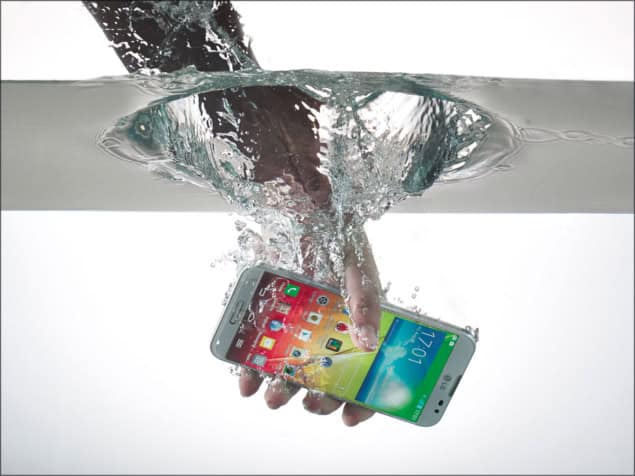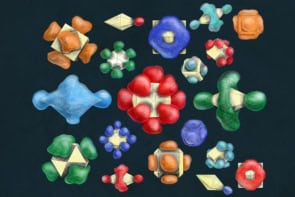Ultrathin polymer and nanostructured coatings are not only setting records for their ability to repel water, but also attracting significant commercial interest, writes Matthew Chalmers

Of all the reasons given to mobile-phone manufacturers for broken handsets, top of the list are rainwater, toilets and washing machines. But perhaps not for much longer, thanks to nanocoatings that cause water droplets to simply roll off a surface as they might a plant leaf. UK firm P2i has recently installed numerous plasma-deposition machines in Motorola production lines to coat handsets with a tough, splash-proof polymer layer. More than 60 million electronic devices have already been treated using the technique and the company is about to release a “dunkable” coating that will keep a device functioning after being submerged for up to 30 minutes.
P2i, which was spun out from the UK’s Ministry of Defence a decade ago, developed a pulsed-plasma deposition process that applies an ultrathin polymer coating onto the internal and external surfaces of mobile devices. The invisible, Teflon-like layer dramatically lowers the surface energy of a material, which makes the water bead and allows “pretty much anything” to be coated with it in a matter of seconds, according to the firm’s chief technology officer Stephen Coulson. “It can be applied to any material, such as clothing, shoes and cardboard,” he says. “Such coatings also have low liquid retention, so you get less cross contamination between surfaces, and they could also be used for filtration and even to make fire-retardant surfaces.”
Non-wetting technology first garnered attention in the 1930s and 1940s when scientists started to understand how nature does it. Studies of duck feathers, for instance, revealed the crucial role of trapped air in keeping water off but it also became clear that the microscopic structure of a surface was vital too because it controls the angle that a droplet creates with it. A droplet landing on a textured surface, such as the lotus leaf, has a contact angle of up to 170°, making it almost spherical and classifying the leaf as “superhydrophobic”.
Numerous sprays and products have been engineered to mimic the lotus leaf’s behaviour, but our ability to characterize and fabricate structures at the micro- and nanoscale has led to an explosion in this subject over the last 20 years, says Kripa Varanasi of the Massachusetts Institute of Technology (MIT) in the US. Texture amplifies the intrinsic wetting properties of a material, allowing researchers to design even more extreme hydrophobic coatings, including those engineered to deal not just with static droplets, but impacting ones.
Last year, Varanasi and co-workers set a new record for superhydrophobicity by structuring materials including silicon, copper and aluminium with ridges that make droplets rebound more easily when they strike the surface. The patterns, which are similar to those found on butterfly wings and nasturtium leaves, minimize the contact time between the drop and the surface, and make the material 40% more hydrophobic than previously thought possible (Nature 503 385). The principle could have important industrial applications in enhanced waterproofing, says Varanasi, for example to reduce the formation of ice on power lines and aero-engine turbines.
Tough challenge
The main hurdle in getting such coatings widely adopted is to ensure they are durable. The plasma technology used by P2i to coat mobile devices bonds the coating covalently to a material surface, which is hardy enough to survive the rigours of everyday use. But hydrophobic coatings that can withstand the much harsher environment of a steam turbine could deliver massive energy savings because up to 20% of losses in such machines come from tiny droplets settling on the blades and forming a thin film, explains Varanasi. His group is currently investigating the use of special ceramics and other covalently bonded coatings for commercialization in the energy industry, and is also targeting clathrate-proof surfaces for the oil and gas sector.
In 2012 the MIT group founded “Liquiglide” to commercialize coatings that allow 100% dispensing from containers by replacing the air pockets between structured surfaces with a lubricant. The technology, which is due to hit the market next year, generates a very thin Van der Waals film between a product and the substrate allowing consumers to extract every drop of ketchup or toothpaste from a container. “The beauty with this is that you don’t have to rely on polymers, you just need a lubricant that doesn’t dissolve in your product,” Varanasi told Physics World.
According to Coulson, who was a PhD student at Durham University in the UK when he invented P2i’s polymer-coating technology to provide soldiers with protective clothing, we are on the brink of a smart-coating revolution. Today, P2i has 62 patent families and is focusing on making electronic boards not only hydrophobic but electrically isolating, as well as developing protecting filters that repel water while allowing air to flow. “There are lots of liquid-based solutions out there, but most tend to shrink-wrap a product rather than bind to it,” says Coulson. “The key is how you apply coatings and make the process cost-effective.”
- P2i’s story can be read in full in the inaugural issue of IOP Publishing’s new journal Translational Materials Research



